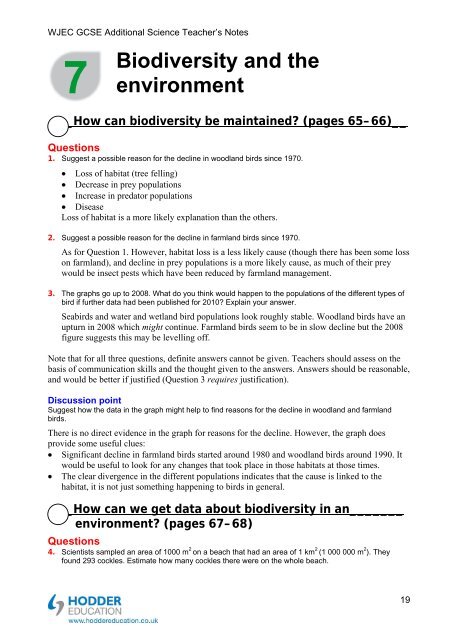Teacher's notes and answers to questions in the book - Hodder Plus ...
Teacher's notes and answers to questions in the book - Hodder Plus ...
Teacher's notes and answers to questions in the book - Hodder Plus ...
Create successful ePaper yourself
Turn your PDF publications into a flip-book with our unique Google optimized e-Paper software.
WJEC GCSE Additional Science Teacher’s Notes<br />
7<br />
Biodiversity <strong>and</strong> <strong>the</strong><br />
environment<br />
_How can biodiversity be ma<strong>in</strong>ta<strong>in</strong>ed (pages 65–66)__<br />
Questions<br />
1. Suggest a possible reason for <strong>the</strong> decl<strong>in</strong>e <strong>in</strong> woodl<strong>and</strong> birds s<strong>in</strong>ce 1970.<br />
Loss of habitat (tree fell<strong>in</strong>g)<br />
Decrease <strong>in</strong> prey populations<br />
Increase <strong>in</strong> preda<strong>to</strong>r populations<br />
Disease<br />
Loss of habitat is a more likely explanation than <strong>the</strong> o<strong>the</strong>rs.<br />
2. Suggest a possible reason for <strong>the</strong> decl<strong>in</strong>e <strong>in</strong> farml<strong>and</strong> birds s<strong>in</strong>ce 1970.<br />
As for Question 1. However, habitat loss is a less likely cause (though <strong>the</strong>re has been some loss<br />
on farml<strong>and</strong>), <strong>and</strong> decl<strong>in</strong>e <strong>in</strong> prey populations is a more likely cause, as much of <strong>the</strong>ir prey<br />
would be <strong>in</strong>sect pests which have been reduced by farml<strong>and</strong> management.<br />
3. The graphs go up <strong>to</strong> 2008. What do you th<strong>in</strong>k would happen <strong>to</strong> <strong>the</strong> populations of <strong>the</strong> different types of<br />
bird if fur<strong>the</strong>r data had been published for 2010 Expla<strong>in</strong> your answer.<br />
Seabirds <strong>and</strong> water <strong>and</strong> wetl<strong>and</strong> bird populations look roughly stable. Woodl<strong>and</strong> birds have an<br />
upturn <strong>in</strong> 2008 which might cont<strong>in</strong>ue. Farml<strong>and</strong> birds seem <strong>to</strong> be <strong>in</strong> slow decl<strong>in</strong>e but <strong>the</strong> 2008<br />
figure suggests this may be levell<strong>in</strong>g off.<br />
Note that for all three <strong>questions</strong>, def<strong>in</strong>ite <strong>answers</strong> cannot be given. Teachers should assess on <strong>the</strong><br />
basis of communication skills <strong>and</strong> <strong>the</strong> thought given <strong>to</strong> <strong>the</strong> <strong>answers</strong>. Answers should be reasonable,<br />
<strong>and</strong> would be better if justified (Question 3 requires justification).<br />
Discussion po<strong>in</strong>t<br />
Suggest how <strong>the</strong> data <strong>in</strong> <strong>the</strong> graph might help <strong>to</strong> f<strong>in</strong>d reasons for <strong>the</strong> decl<strong>in</strong>e <strong>in</strong> woodl<strong>and</strong> <strong>and</strong> farml<strong>and</strong><br />
birds.<br />
There is no direct evidence <strong>in</strong> <strong>the</strong> graph for reasons for <strong>the</strong> decl<strong>in</strong>e. However, <strong>the</strong> graph does<br />
provide some useful clues:<br />
Significant decl<strong>in</strong>e <strong>in</strong> farml<strong>and</strong> birds started around 1980 <strong>and</strong> woodl<strong>and</strong> birds around 1990. It<br />
would be useful <strong>to</strong> look for any changes that <strong>to</strong>ok place <strong>in</strong> those habitats at those times.<br />
The clear divergence <strong>in</strong> <strong>the</strong> different populations <strong>in</strong>dicates that <strong>the</strong> cause is l<strong>in</strong>ked <strong>to</strong> <strong>the</strong><br />
habitat, it is not just someth<strong>in</strong>g happen<strong>in</strong>g <strong>to</strong> birds <strong>in</strong> general.<br />
_How can we get data about biodiversity <strong>in</strong> an_______<br />
environment (pages 67–68)<br />
Questions<br />
4. Scientists sampled an area of 1000 m 2 on a beach that had an area of 1 km 2 (1 000 000 m 2 ). They<br />
found 293 cockles. Estimate how many cockles <strong>the</strong>re were on <strong>the</strong> whole beach.<br />
19

















